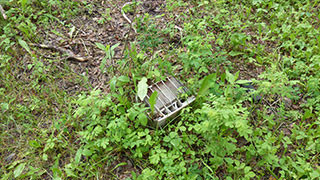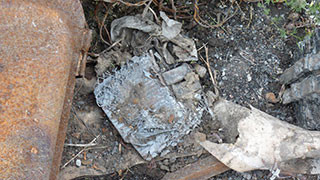Non-urgent government operations are closed December 24 to January 1, reopening January 2. View available services during this period.
Description
Lead is the most common toxin reported in livestock. Most lead exposure and poisoning in cattle occurs as a result of grazing on pasture contaminated with lead. Young calves are particularly attracted to the taste of lead.
Sources of lead include:
- discarded batteries
- farm machinery
- lead-based paints on farm structures
- discarded engine oil
Maximum acceptable lead concentrations in cattle products are:
- Meat: 0.11 mg per kg
- Milk: 0.020 mg per kg
Toxic lead levels (above acceptable levels) in these and other cattle products make them unsafe and unable to enter the food chain.
How to report
If you suspect lead toxicity in your herd, call your veterinarian within 24 hours.
Animal diseases due to toxic substances including lead toxicity in cattle are provincially reportable disease under Alberta's Animal Health Act. Immediate action is required to prevent animal products with toxic lead levels from entering the food chain. Meat and milk from livestock exposed to high levels of lead poses a health risk for humans.
If toxic lead levels are suspected or confirmed in your herd, call your veterinarian immediately.
Veterinarians must report all suspected or confirmed cases to the Office of the Chief Provincial Veterinarian (OCPV) within 24 hours:
Hours: 8:15 am to 4:30 pm (open Monday to Friday, closed statutory holidays)
Phone: 780-427-3448 (also responded to after hours and weekends)
Toll free: 310-0000 before the phone number (in Alberta)
Fax: 780-415-0810
Clinical signs
Common observations
Cattle that have consumed toxic levels of lead might exhibit seizures and sudden death. Sudden death in healthy calves and cows is the main presenting complaint by producers to their veterinarians.
Exposure to toxic levels of lead can also lead to permanent brain damage in cattle.
Calves and cows that appear blind, wander aimlessly and are often separated from the rest of the herd are also common observations reported by producers. Based on reported cases, all age groups of cattle are affected, however, young calves are more commonly affected.
No outward signs
Cattle that are exposed to lead can have elevated levels of lead in their blood without showing any outward signs of clinical disease. The blood lead levels in these cattle can remain elevated above the maximum acceptable concentration of 0.11 ppm for an extended period.
Cattle that have consumed smaller amounts of lead will appear normal, but the lead levels in the body will make the meat and milk unsafe for human consumption until the lead has been eliminated.
Where it’s found

Figures 1-2: Examples of lead acid batteries where the plastic casing has disintegrated exposing the lead plates that cattle like to lick.

Lead is a very stable metal and will remain in soil indefinitely.
All cases of lead exposure and poisoning in cattle reported to the OCPV to date occurred in cattle grazing on pasture. In all cases where the source of lead was identified, improperly discarded lead acid batteries from automobiles and farm machinery were found. Cattle, especially calves, find the metal tasty and will actively seek it out.
Since 1992, lead-based paints for indoor use are virtually lead-free. However, there may still be a significant exposure hazard to animals that have access to old outbuildings, especially those painted before 1950 with lead-based paint. Lead remains even in the ashes of buildings painted with lead-based paint and subsequently burned. The ashes therefore may also be a source of exposure.
Used engine oil from vehicles using unleaded gas is no longer a major threat of lead source. However, old spills or dumpsites may still be contaminated.
Discarded batteries
Abandoned and discarded batteries that have gone through several freeze-thaw cycles and no longer have intact cases are the most dangerous. The lead plates are exposed and easily accessible by animals.
Discarded batteries are usually found around:
- abandoned vehicles and farm machinery
- old dumps and disposal sites
- homesteads and outbuildings
- fence lines
If the batteries have broken open, it is important to do a thorough job cleaning up not only the lead plates but also the soil around the battery.
To avoid lead contamination, always safely dispose of used lead acid batteries at collection stations. See Prevention and control below.
How it spreads
Lead toxicity does not spread from animal to animal. However, if animal products with high levels of lead enter the food chain they pose a health risk for humans.
Risk to humans
Products derived from animals affected by toxic substances are a threat to human and animal health. It is important to identify cattle with elevated lead levels, and take precautions to prevent contaminated products such as milk and meat from these animals entering the human food chain.
Prevention and control
Preventing contamination
It is important to reduce the risk of lead contamination to pasture and farmland, and to watch for signs of discarded batteries or other sources of lead.
Battery disposal
Do not discard old used lead acid batteries from automobiles and other farm machinery on pasture land, or bury them on the farm.
Lead acid batteries should always be recycled as a hazardous waste and safely disposed. Collection stations are located across Alberta where batteries, paint and engine oil can be dropped off. Visit the Recycling Council of Alberta website to find the nearest location to dispose spent lead acid batteries.
Cattle should not graze in contaminated areas. If pasture land is contaminated, clean it up to remove the lead source and any contaminated soils.
Proper carcass disposal
Toxic lead levels in cattle products make them unsafe and unable to enter the food chain, thereby requiring humane destruction and proper disposal of affected animals.
Animals that have died from lead toxicity must be safely buried to prevent lead toxicity in wildlife.
See also Livestock mortality management.
Monitoring
Producers and private veterinarians have been diligent and cooperative in reporting cases of lead toxicity to the OCPV.
In turn, the Alberta government is monitoring exposed animals in affected herds to prevent meat and milk from animals whose blood levels exceed the maximum acceptable concentration from entering the human food chain.
When acute lead toxicity is confirmed in an animal, the entire group of potentially exposed animals must be tested for blood lead levels. In addition, the source of the lead exposure in the pasture must be determined and removed to prevent re-exposure of these or future animals using the area.